
by jhwildlife | Aug 23, 2018 | Blog
by Kate Maley, Lead Bird Bander
Since Chuck Schneebeck started the Bluebird Trail in 2003, members of the Jackson community have endeavored to create nesting habitat for Mountain Bluebirds and other native cavity-nesters along the southwestern edge of the National Elk Refuge. After many years of observation and data collection, at least one thing is clear: the birds are definitely using the nestboxes! But what effect are the boxes having on the population?
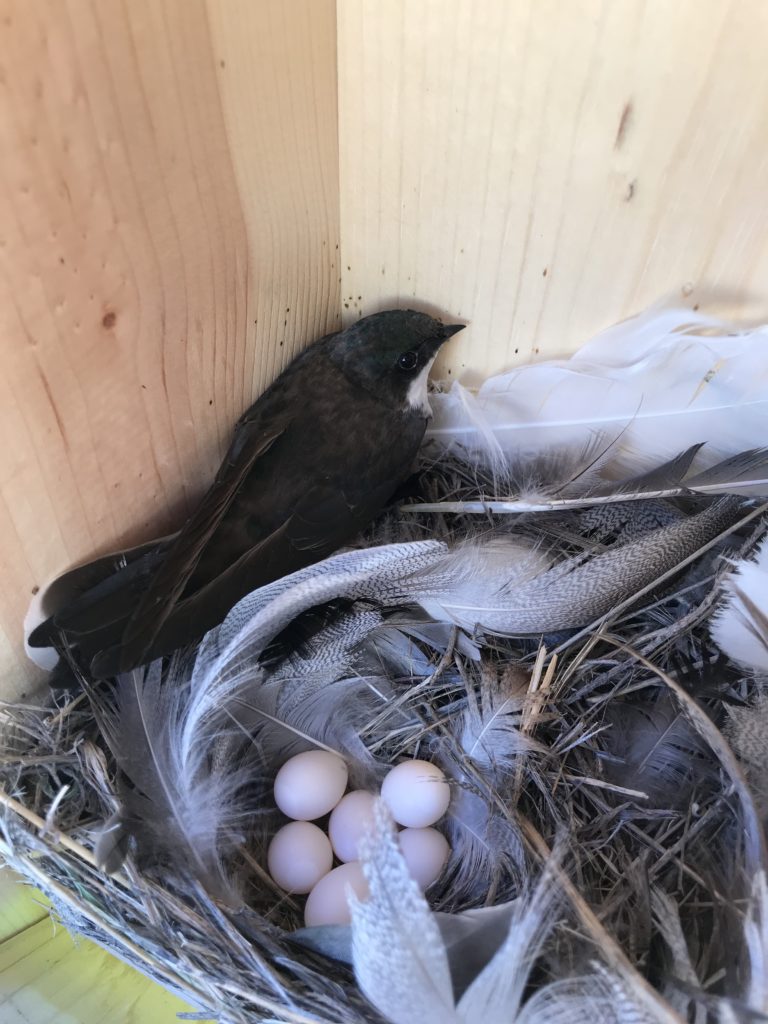
While we focus on Mountain Bluebirds, we are equally pleased to see other native cavity nesters using the nestboxes! Tree Swallows are the most abundant nesters along the Bluebird Trail, though they arrive after most bluebirds have settled into their territories for the season.
Jackson Update:
In 2017, JHWF began expanding upon the existing data and investigating new questions when our previous bander Allison Swan and monitoring volunteers started placing USGS aluminum bands and a unique series of color bands on Mountain Bluebird nestlings and one adult female. These color bands, or “bling,” allow us to identify each individual bird as it disperses from its nest and, hopefully, returns to a similar area the following year to raise some little bluebirds of its own!
Still in the early stages of the banding project, we don’t have many definitive answers yet, but we are learning lots! Of the 98 bluebird nestlings that were banded in 2017, only a handful have been resighted this year. This isn’t as surprising as it may initially sound, however. The first year of a bird’s life is the hardest as they learn to fend for themselves and navigate migration. Optimistically, we estimate that around 50% or fewer birds make it back to their breeding grounds in their second year. Once back in Jackson Hole, they disperse from their original nest site to independently begin a family of their own. Where do they go? That’s one of the things we’re hoping to discover!

Max Frankenberry, Assistant Bander, secures the color bands on a nestling to help ensure they will stay on and be able to be spotted next year.
While migration is still a taxing journey for adult bluebirds, they do benefit from experience. In addition, adult bluebirds tend to have higher site fidelity, meaning they are more likely to return to the same site to breed for multiple years. So far, the one banded adult mountain bluebird did, in fact, return to the exact same nestbox where she was banded in 2017!
Admittedly, 2018 was a tough year for nestbox inhabitants as almost half of the nestboxes were within a stretch affected by predation events. (Exact numbers are still being determined as we close out the season and compile the data.) In response, we placed a number of predator guards that are recommended by the North American Bluebird Society. Fortunately, most of the guards did seem to effectively prevent the depredation of a second nesting attempt. Even with the challenge of a predator, nearly all of the 112 available nestboxes were occupied by native cavity nesters (Mountain Bluebirds, Tree Swallows and House Wrens). Of the Mountain Bluebird nests, about 75% successfully fledged young. In total, 72 nestlings were banded in 13 nestboxes (some had two broods throughout the season).
Now, we’ve reached the point in the season when bluebirds of all ages disperse from their nest sites and seem to gather into groups by age to take advantage of the last of summer’s bounty and fatten up before migration. So, if you keep an eye out for “Bluebirds with Bling,” you’re likely to see some from the 2018 cohort (indicated by a peach color band on the bird’s right leg, closest to the body) and possibly some from 2017 as they group up prior to beginning journey south.
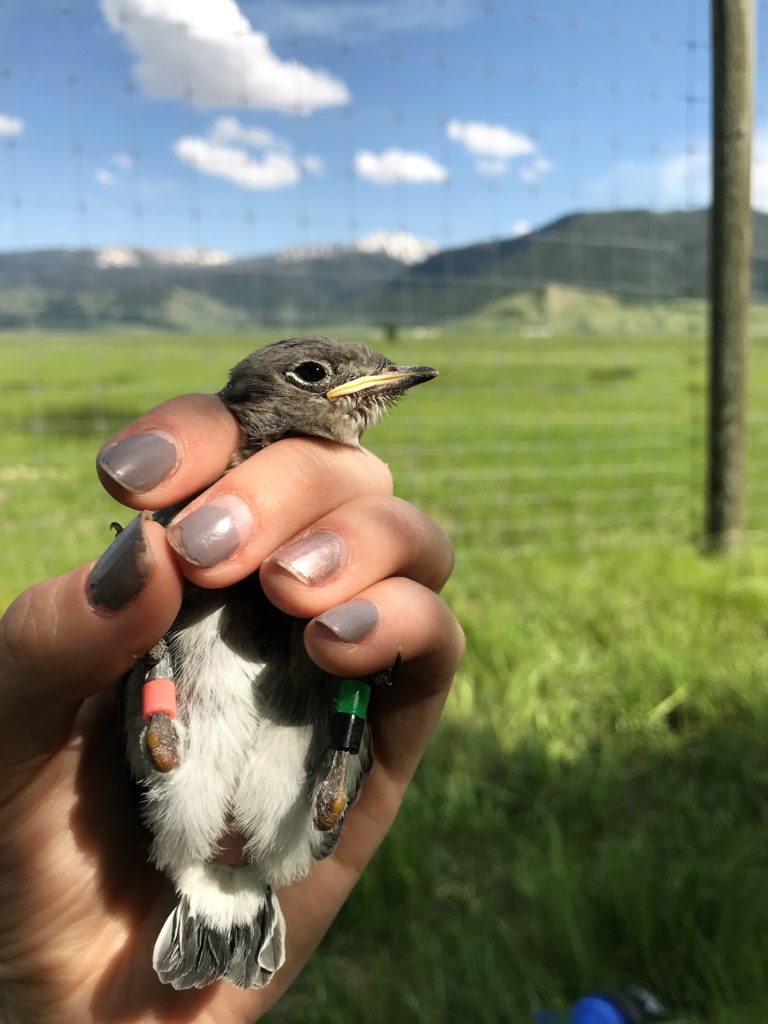
Meet one of the members of 2018’s cohort of bluebirds! The location of the peach color band (top right) will allow us to easily identify it as having hatched and been banded this year. Left: Black over Green, Right: Peach over Silver
Dubois Update:
Last year was also the first year of the Dubois Community Bluebird Trail. The project continued in 2018 with 35 nestboxes monitored by 9 volunteers. We’re still waiting to finalize the data prior to analyzing the results from the season, but we’re looking forward to what we find out!
Thank you to all our hardworking volunteers and partners in both Jackson and Dubois who make this project possible!
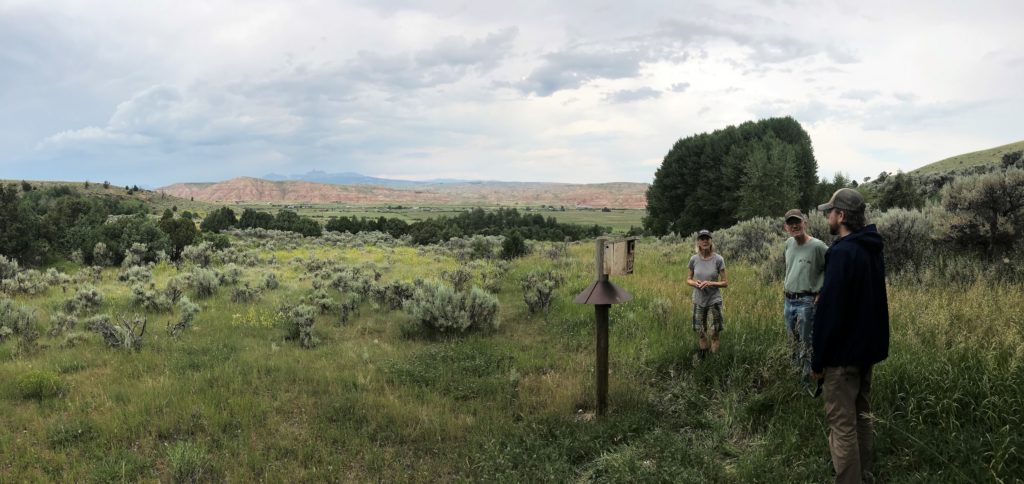
Nancy and Blair Butterfield were kind enough to give us an update and tour of their nestboxes when we visited Dubois in July.
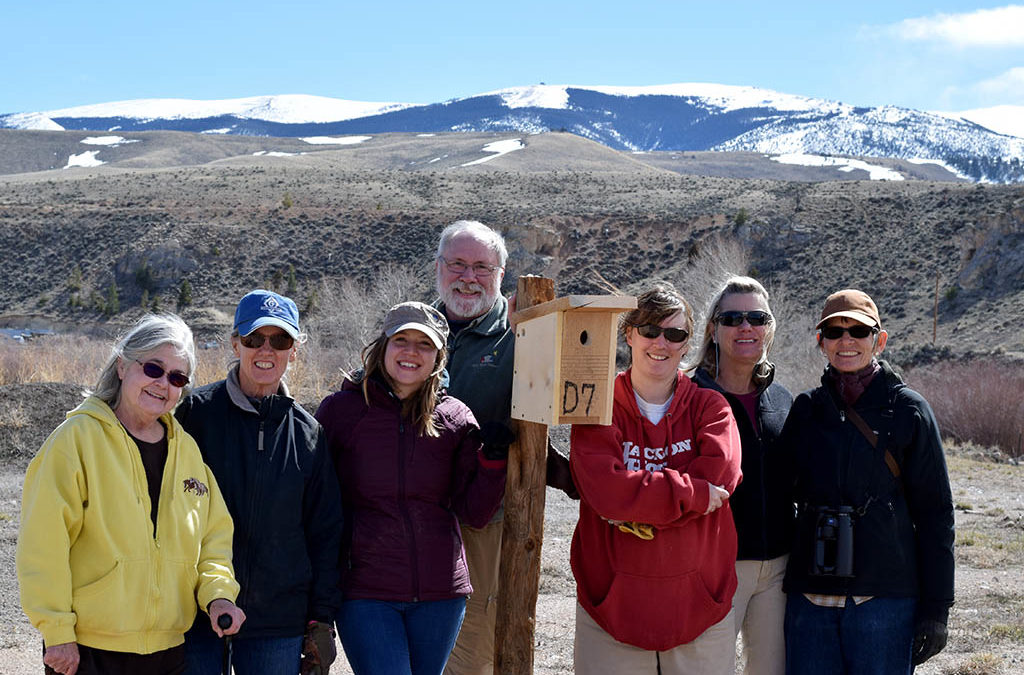
by jhwildlife | Apr 19, 2017 | Blog, Nature Mapping Jackson Hole
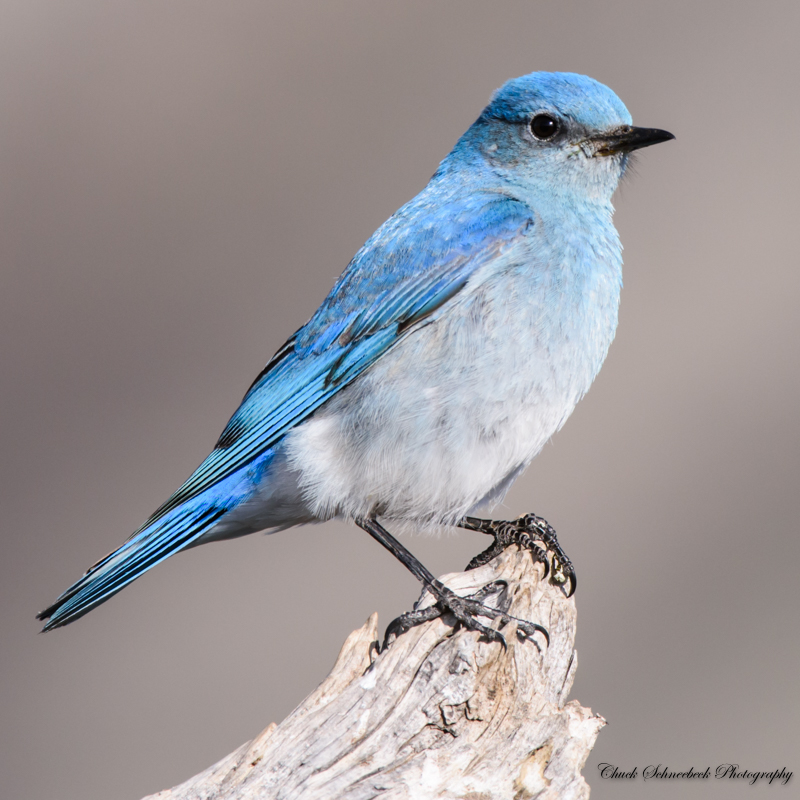
Photo by Chuck Schneebeck
“O bluebird, welcome back again.
Thy azure coat and ruddy vest,
Are hues that April loveth best.”
– John Burroughs
The great writer and conservationist John Burroughs shared his love of the Eastern Bluebird brilliantly, with words that express abiding affection for the “bluebird of happiness.” The resident of our parts, the Mountain Bluebird, has no shortage of admirers uplifted by that bright blue flash across the landscape. Here we are in April, and the Mountain Bluebirds have returned! We see them flitting from post to post along the National Elk Refuge fence, and spiriting their way across the grassy meadows of South Park. After a long winter, could there be a more hopeful harbinger?
At the Jackson Hole Wildlife Foundation, we have the honor of continuing a Mountain Bluebird monitoring program that Chuck and Carol Schneebeck and friends launched more than a decade ago. With the help of dozens of volunteers over the years, we have tracked the number of boxes utilized and by which species, the number of eggs laid, the number of nestlings fledged, and other valuable data to help us understand the lives of bluebirds.
While that data and our growing knowledge of the bluebird is important, perhaps the real power of the program lies in its affect on the people who participate. For anyone who has peered into a box to find a fresh egg or a newly hatched featherless bird, there is no mistaking the thrill of the experience. It can be hard to contain the joyful feeling that John Burroughs described – nearly always shared with others. As we continue to monitor the success of the Mountain Bluebird Nestbox trail along the National Elk Refuge, we’re also exploring ways to share what we’ve experienced with others in neighboring communities. In early April, we had the pleasure of working with a committed group of bluebird enthusiasts in Dubois to install 35 boxes to create the Dubois Community Bluebird Trail. Our super volunteer and bluebird trail expert Tim Griffith provided a trail monitoring orientation to the group at the Dubois Museum. Associate Director Kate Gersh spoke about the success of the nestbox trail in Jackson and why Jackson Hole Wildlife Foundation is interested in partnering with Dubois in a similar effort.
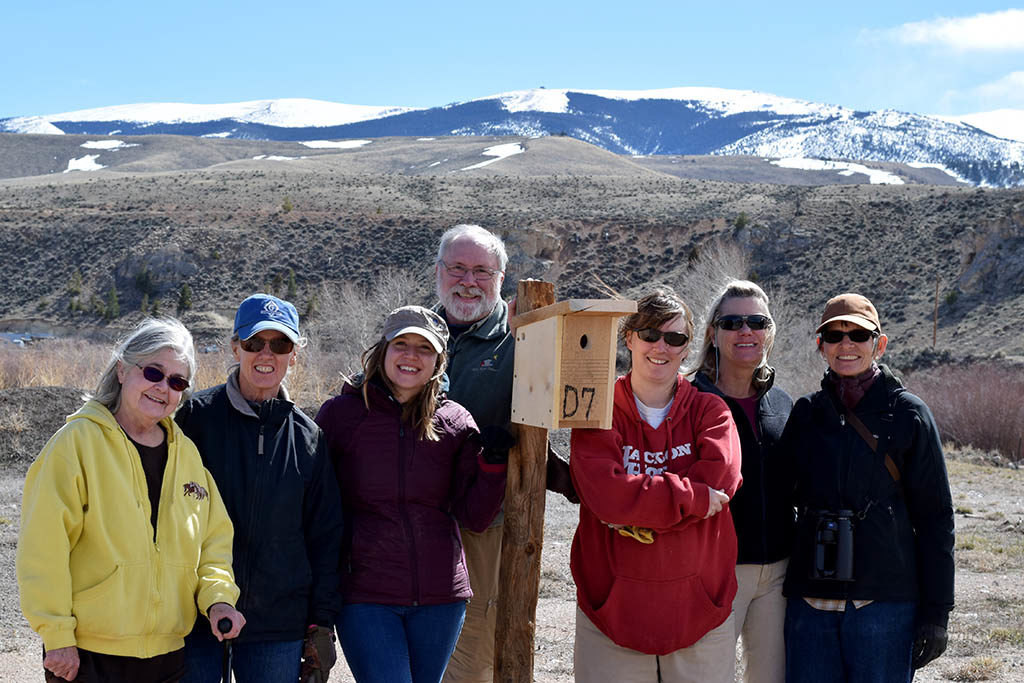
Andrea, Deb, Kate, Tim, Johanna, Bridget and Susan install a box at the Warm Valley Lodge assisted living center in Dubois.
As Aldo Leopold famously said, “a land ethic … evolves in the minds of a thinking community.” Leopold recognized that such an ethic might emerge in the individual first through observation, and the recording of what one has observed. Through this process, one becomes more aware of what is going on around them. Combining individual observations in a community monitoring program brings people together around a shared appreciation for wildlife. Our hope is that bringing communities together to share their observations and interactions will build stronger connections between stewards of Greater Yellowstone lands. Who better than the bluebird to act as that joyful ambassador?
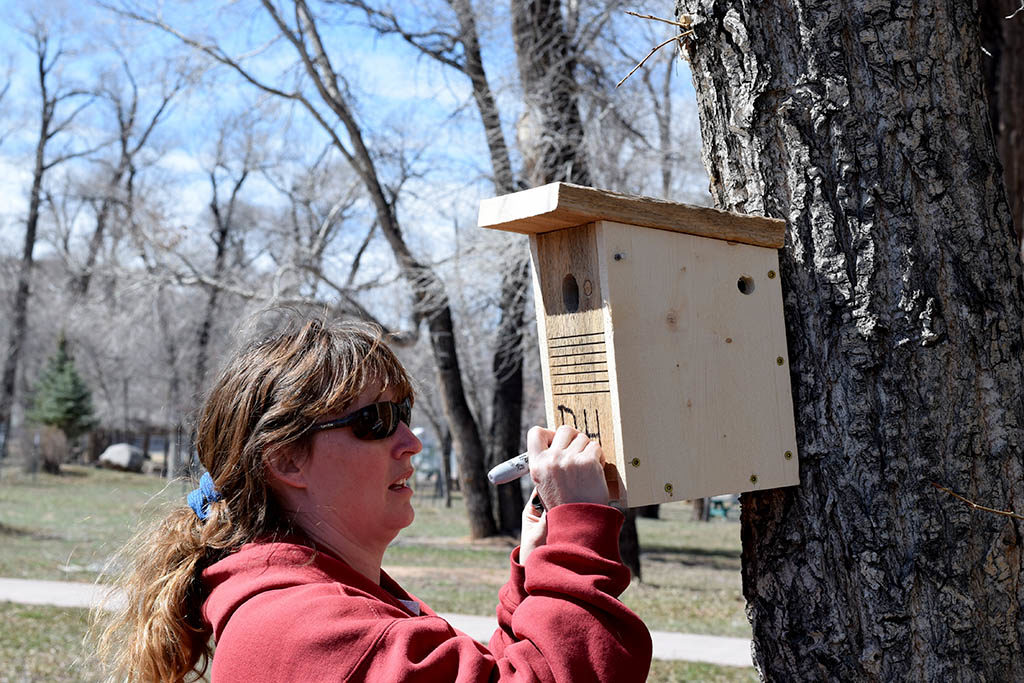
Lead project coordinator Johanna Thompson of the Dubois Museum & Wind River Historical Center makes a Dubois box “official.”
The Mountain Bluebird Nestbox Trail monitoring effort is one of many projects of Nature Mapping Jackson Hole. Each project is designed to increase our local knowledge of many species while advancing our community’s land ethic. Expanding the boundaries of that community might help ensure that our area’s ecosystem is preserved and protected in perpetuity, joining people and lands around common values.
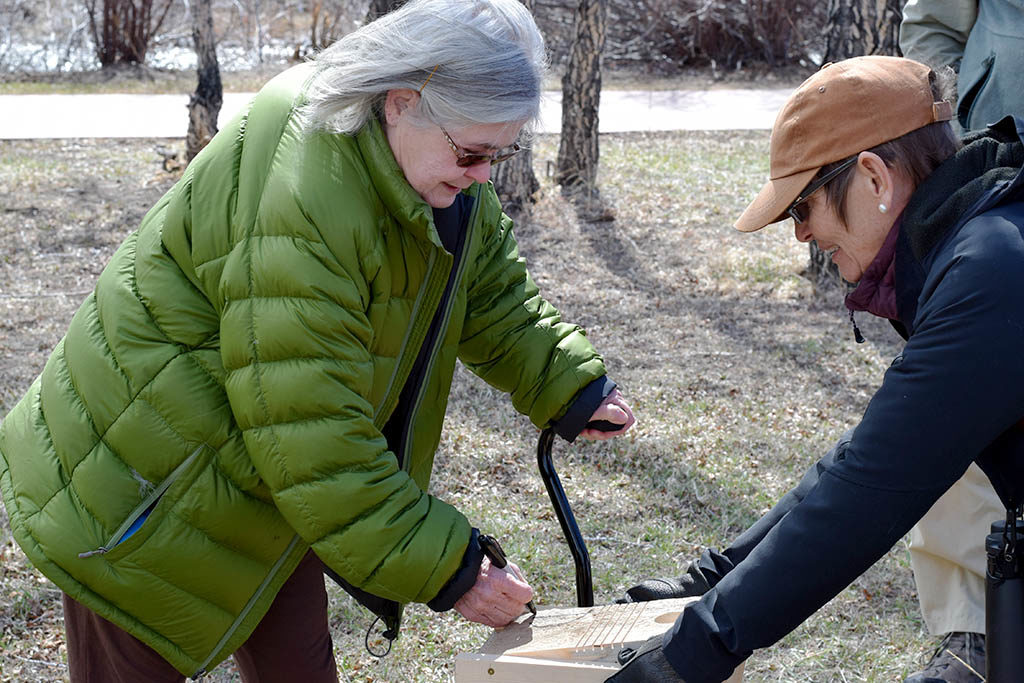
Key volunteer Andrea Billingsley inscribes “D1” on the first box of the Dubois Community Bluebird Trail while Susan Hill supports and celebrates.
View a full gallery of fun images from “Bluebird Day” in Dubois.

Nancy and Blair Butterfield prepare to install two boxes on their Dubois property with assistance from Jackson Hole Wildlife Foundation staff.
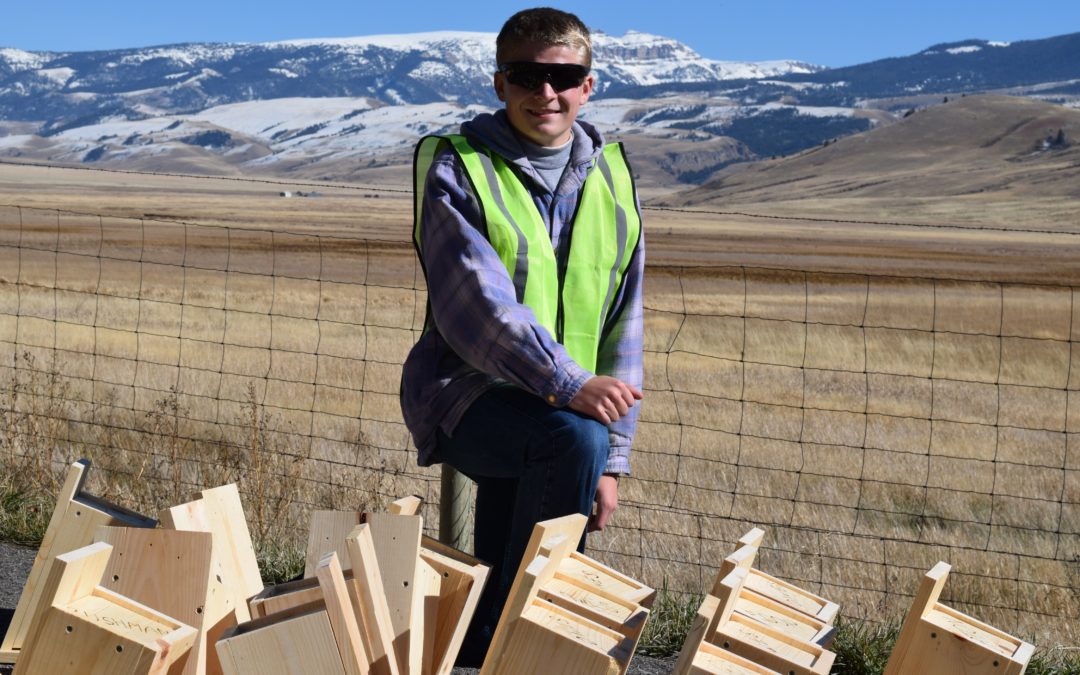
by jhwildlife | Oct 26, 2016 | Blog, Nature Mapping Jackson Hole

Eagle Scout is the highest achievement or rank attainable in the Boy Scouting program of the Boy Scouts of America. The requirements necessary to achieve this rank take years to fulfill, and must include completion of an extensive service project that the Scout plans, organizes, leads, and manages. Luckily for the Jackson Hole Wildlife Foundation, prospective Eagle Scout Maclain Smith from Utah, made us the beneficiary of his service project. This past Friday afternoon, Maclain came up to Jackson to install 52 Mountain bluebird nestboxes that he and fellow Scouts constructed by hand.
With lots of laughs and great spirit, Maclain and nine of his family members spent a sunny autumn afternoon installing new pinewood nestboxes on half of our Mountain bluebird trail that runs along the western boundary of the National Elk Refuge. Our old nestboxes (that served their purpose for 13 years!) were taken to Teton Recycling Center where they will be repurposed into wood mulch and used for gardening and landscaping purposes. After 13 years, we felt it time to retire the old nestboxes as they had seen many repairs over the years, but their deteriorating condition was starting to present challenges in terms of predator control and protecting nests from bad weather conditions.
Not only are we fortunate to have the help of Maclain, but we currently have two more prospective Eagle Scouts producing a total of 72 additional nestboxes that will be installed this coming spring. Of these 72 — the other half of our trail will receive 52 new nestboxes, we are looking into placing additional nestboxes elsewhere on the National Elk Refuge, and keep a few in storage. Thank goodness for Scouts!
Click here to see a photo gallery documenting Maclain installing new Mountain bluebird nestboxes with the help of his family and JHWF staff.
Click here to read an account of the project published by the National Elk Refuge.
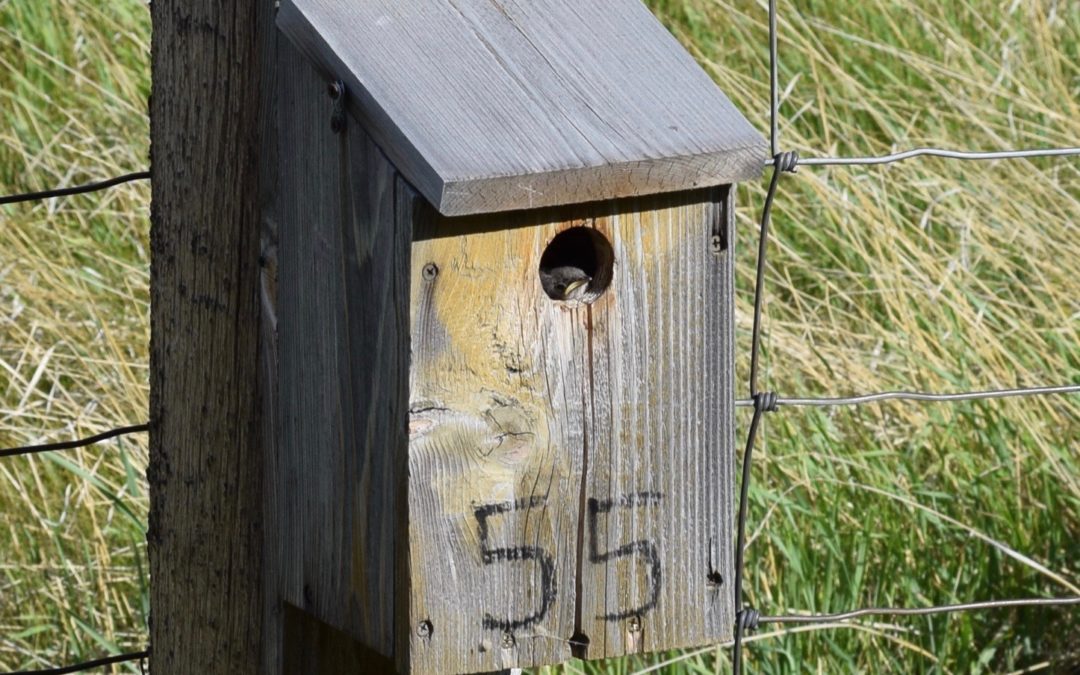
by jhwildlife | Aug 8, 2016 | Blog, Nature Mapping Jackson Hole
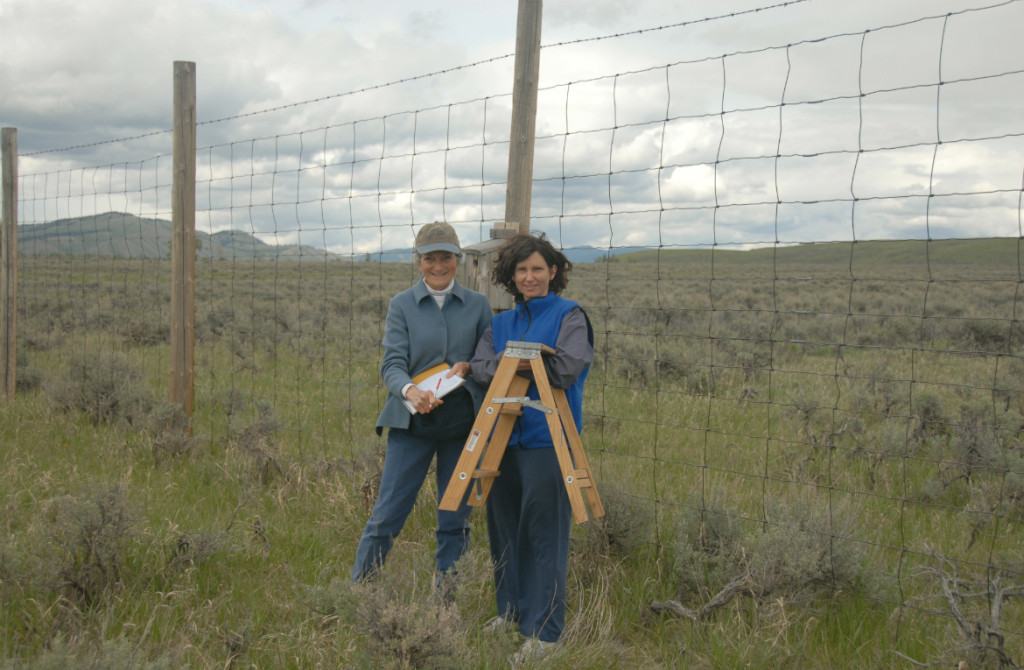
For thirteen years, volunteers have been maintaining a bluebird trail along the boundary of the National Elk Refuge. It is the largest Mountain Bluebird trail in the United States, and it provides essential nesting habitat for these iconic birds, as well as long-term scientific data. This citizen science project is core to the mission of the Jackson Hole Wildlife Foundation: Combining science and the celebration of wildlife.
About Mountain Bluebirds
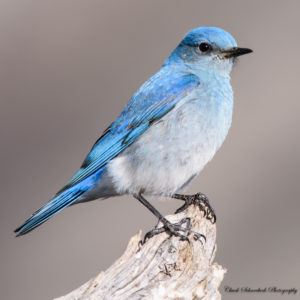
A male Mountain Bluebird. Photo: Chuck Schneebeck
The brilliant-blue males arrive in Jackson Hole starting in March and begin to select and defend boxes. The pale blue-gray females arrive shortly thereafter and choose a mate based solely on the quality of the nest cavity. They build the nest to fit several eggs—similar in color to Robins’ eggs, but smaller. The males feed the incubating female, often hovering and diving to catch insects such as beetles and grasshoppers.
Phyllis Greene, long-time monitor and past project coordinator, has observed: “They lay one egg a day, but the eggs hatch out all at once. It’s fun to watch. I have seen the chicks peck out through the shell. When they hatch, they are the size of your pinky and nude. First thing, they have their mouths open for food. They are adorable.” The chicks develop pin feathers and then “become more of a bird.” The monitors observe the nestlings from afar after the first 12-14 days so that the birds won’t fledge prematurely. Then after about 3 weeks total, ”They fly off. ‘Ok, good-bye.’ It’s sad. They are so gorgeous.” Adult males depart Jackson in early August. The females and young leave a little later. These birds, considerably smaller than a robin, migrate as far south as Mexico and Central America.
Nesting success is tenuous. While Tree Swallows arrive two weeks later than Mountain Bluebirds – after many bluebirds have claimed boxes – they often out-compete the bluebirds when they would otherwise attempt a second brood. Tree Swallows are a beautiful, native bird, so their presence is enjoyed as well, despite the challenge to bluebirds. Future nestbox plans aim to accommodate the greatest number of both species. Also, according to project coordinator Tim Griffith, weasels and raccoons have been known to raid the nests, which lowers the success rate. Overall, the North American Breeding Bird Survey indicates Mountain Bluebird populations declined by about 26% between 1966 and 2014. We will continue to analyze our data to see how the birds have been faring here in Jackson Hole.
The Origin of the Mountain Bluebird Nestbox Trail Project
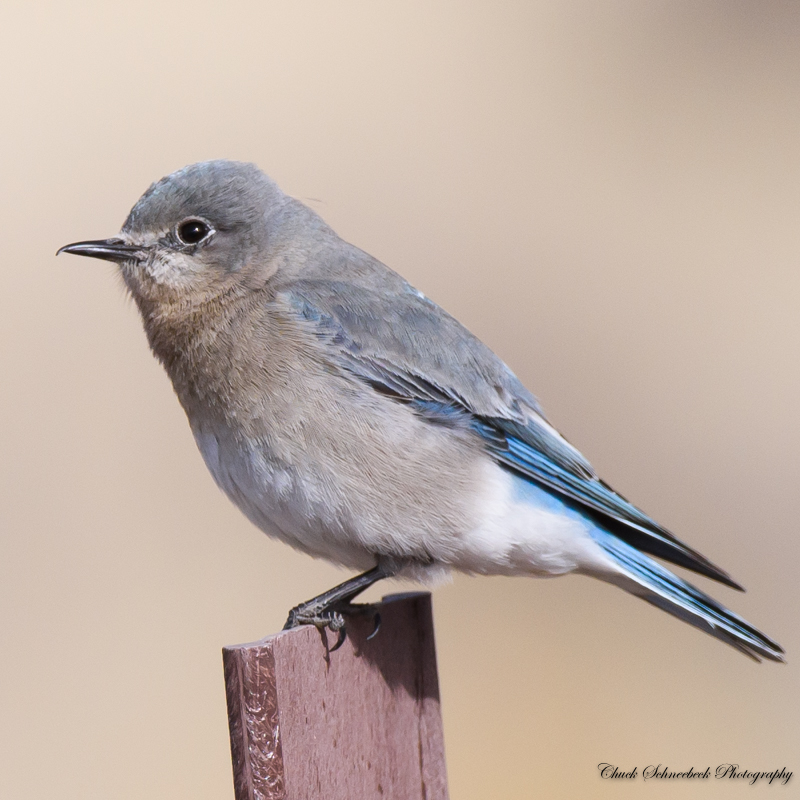
Female Mountain Bluebird. Photo: Chuck Schneebeck
Chuck Schneebeck started the project in 2003. He read a study about the loss of aspens due to intensive ungulate grazing on the National Elk Refuge (NER). Bluebirds are cavity nesters, naturally using holes in old aspen trees carved out by woodpeckers or formed by a rotted tree limb. On the Refuge, the loss of standing aspens due to elk browsing meant the loss of nesting habitat. In an informal survey, “We found only one nest from Flat Creek to the Gros Ventre River, in an electrical box by the visitor center.” Chuck realized that to mitigate the impact of grazing, “We could build cavities: nest boxes.” Having worked on a bluebird trail for the National Audubon Society in Dubois, WY, he knew how to start.
From the beginning, Chuck engaged the Jackson Hole Wildlife Foundation and community. The Foundation provided funds for the materials and Chuck donated his labor. With the cooperation of NER, he and others set up 105 boxes 100 yards apart placed five or more feet high along the western boundary fence. Citizen science volunteers were assigned about 15 boxes each, which requires a mile walk and about an hour a week to monitor. They start surveying in April and continue into August. Monitors also help clean out and repair the boxes in the off-season.
The Monitoring Process
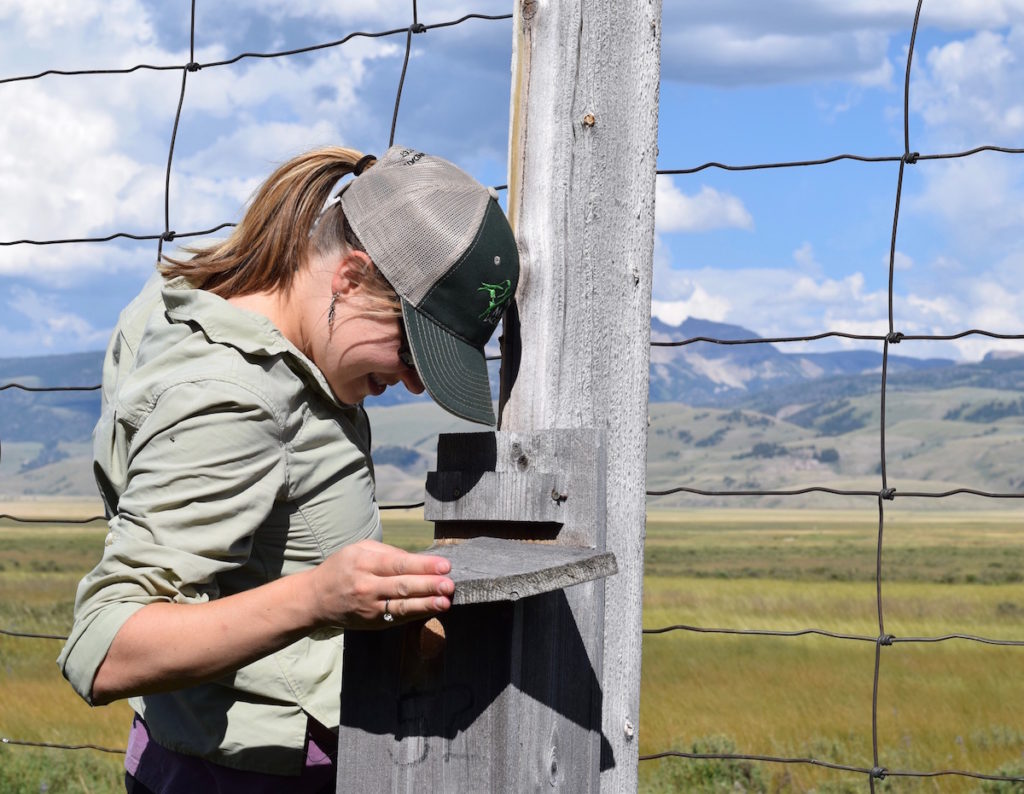
Kate Gersh, JHWF Associate Director and project monitor
Phyllis Greene’s approach is, “We talk to the box and tap first, saying ‘Hi, coming to see you. How you are doing?’ Then we open the lid and look in. Mom just looks up and blinks her yes and says ‘how do you do?’ We close the lid then record what we saw. They don’t mind the monitoring and we never touch them.“
Phyllis goes on to say that the monitors become “very maternal or paternal. We want to give the birds a chance because they are almost extinct out here.”
While monitors are surveying along the road, people often stop and ask what they are doing. “We explain the project and they respond, ‘That’s great!’ People get excited and appreciate that someone is doing something for these little birds,” recalls Phyllis.
How do volunteers feel about the project?
For Chuck Schneebeck – project founder – while the project does not supply all the complexity that the bluebirds need, “We are doing what we can. The fundamental part is that we have cavities and bluebirds have been using them for a long period of time. So there are lots of birds now.”
Phyllis Greene, who took over the project from Chuck: “The important thing is for the birds to have an opportunity to have a nest, to get out of the weather and survive. We want to make sure they have a chance. Originally they were almost extinct in lots of places throughout the US, not only here. Anytime we can help wildlife sustain itself and still be independent is a great idea.”
Jon Mobeck, Executive Director of JHWF says the project fits the mission of the organization. “This is a visible way to demonstrate how to mitigate our impacts of development on wildlife. It is a perfect example of the community coming together and helping out this beautiful species. It combines science and the celebration of wildlife.” And more personally, Jon had no experience with birds prior to taking on 12 boxes with the JHWF staff. He is becoming a bird watcher. “Now I have a whole new way of observing the environment. It has been eye opening and ear opening. A tremendous gift.”
Tim Griffith, our new project coordinator, has been engaged with Eastern Bluebird trails for years in Indiana before moving here a year ago: “This is the largest registered Mountain Bluebird Trail in the continental U.S. Mountain Bluebirds are crashing throughout the region. With 13 years of data, we can know more about the population and be responsive to changes in trends upward instead of downward. The more we know about this iconic western species the more we can save and increase their populations here and elsewhere.”
Natalie Fath, Volunteer Coordinator and Visitor Services Manager for the National Elk Refuge: “The ongoing collaboration with the Jackson Hole Wildlife Foundation on the Mountain Bluebird Nestbox Trail Project is essential to ensuring that monitoring, box maintenance, and reporting occurs. The NER is not only supportive of the collaboration, but also depends entirely on volunteer citizen scientists to give this project life due to Refuge full-time staffing limitations. Without volunteers, this project would not exist.”
Future Plans
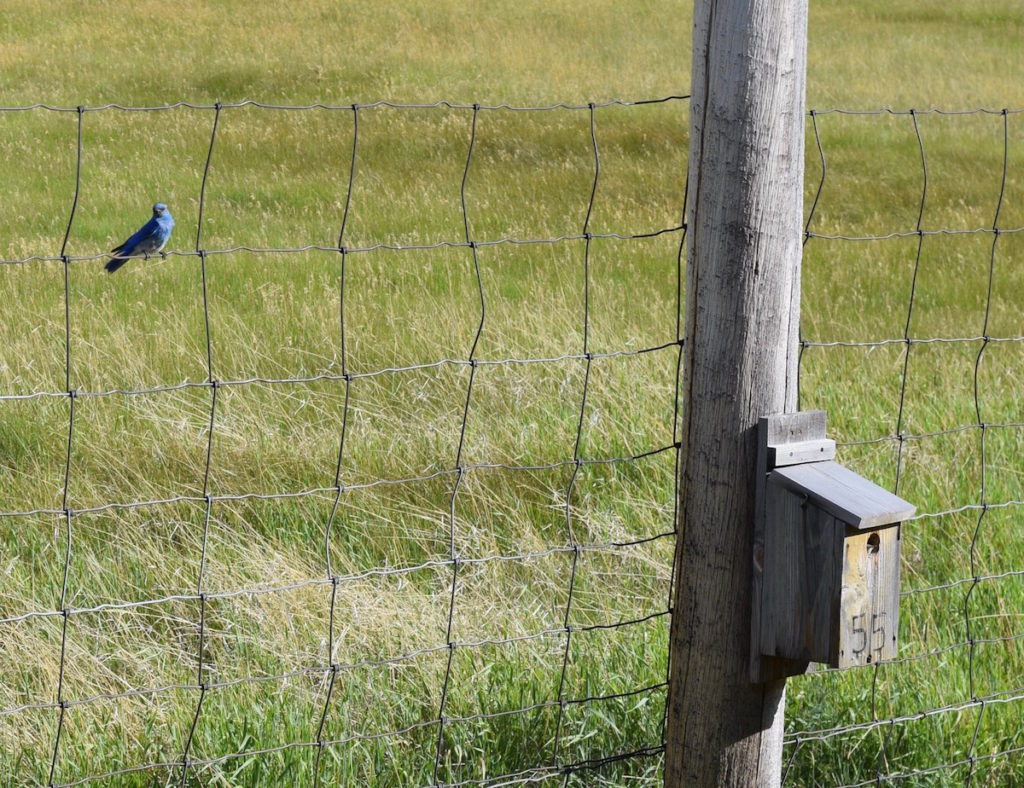
A male bluebird watches as a monitor approaches. Nestlings are getting ready to fledge.
Next year, Tim plans to start banding birds to see how many return, and to which boxes. Eagle Scouts are ready to repair and build more boxes to place at other areas in the Refuge. Also, we will digitize the years of data for submission into our Nature Mapping database and Cornell’s national NestWatch system.
Jon Mobeck sums it up, “The Nature Mapping Bluebird Nestbox Project is a great way to introduce citizen science to the community. It is a visible and fun project. We welcome new volunteers!”
We thank the ongoing core project volunteers who are still in the valley:
Chuck Schneebeck, Ed Henze, Bert Raynes, Paul Anthony, Phyllis and Joe Greene, Loretta Scott, Larry Kummer, Julianne O’Donoghue, Gretchen Plender, Shelly Sundgren and Dave Lucas; Jon Mobeck, Kate Gersh, Christine Mychajliw, Tim Griffith.
Additional thanks to Jackson Lumber, which often donates cedar wood for the boxes.
Contact Tim Griffith to help out: Timgrif396@gmail.com.
References:
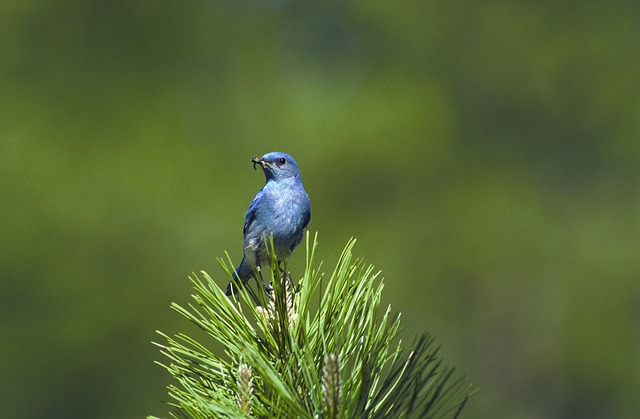
by jhwildlife | Jun 8, 2016 | Blog, Nature Mapping Jackson Hole
As a follow-up to last week’s blog post, unfortunately we have sad news to report. The nest with the five bluebird chicks seems to have been sabotaged and no observable signs exist of the chicks or their parents. Upon arriving at this particular nest box for weekly inspection, the top lid was haphazardly lying on the ground about a foot away; its screws that held it firmly in place were stripped from the wood and only just hanging on by wire. Scratch marks can be seen around the entrance hole. We can’t know for sure what happened, but we suspect we have a weasel hunting our mountain bluebird trail as other nature mappers have reported similar scenarios.
All we can do is remain vigilant to identify the predator and then devise an appropriate solution. It is a reminder to us of the nature of nature, and the circle of life in birth, survival and death — how all in nature are independent and interconnected. However, such involvement as ours through citizen science (while sometimes strongly tugging at our heartstrings) ultimately, still connects us with relevant, meaningful, and real experiences with science.






















